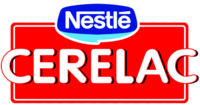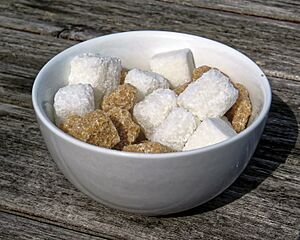Cerelac facts for kids
 |
|
| Owner | Nestlé |
|---|---|
| Introduced | 1949 |
Cerelac is a type of instant cereal made by a company called Nestlé. It's designed for babies and young children, usually between 6 months and 2 years old. Cerelac is meant to be an extra food, not a replacement for breast milk or baby formula. It helps babies get more nutrients as they grow.
The ingredients in Cerelac can be different depending on where it's sold. For example, in some countries, Nestlé often adds sugar to the cereal. In other, wealthier countries, they usually don't add sugar. The Cerelac brand was first created in 1949. It is now sold in many countries around the world.
Contents
What's Inside Cerelac?
Like other baby cereals that have extra nutrients, Cerelac contains important vitamins and minerals. These include iron, which is good for growth, and essential fatty acids. Some Cerelac products also have special helpful bacteria called probiotics. These are the same kinds of good bacteria found in the stomachs of babies who are breastfed.
However, the exact ingredients change from one place to another. In many parts of Africa, Asia, and Latin America, Cerelac often has between two and seven grams of added sugar. But in wealthier countries like the United Kingdom or Germany, it usually does not. Tests show that the amount of sugar in one serving can be like adding a whole sugar cube to it. This added sugar doesn't help babies' health. In fact, it can lead to problems like tooth decay and childhood obesity.
In many countries, it's allowed to add sugar to baby food. Companies don't always have to say how much sugar they've added. Nestlé follows these local rules. So, they add sugar when they can and only tell you the amount if they have to by law.
How Cerelac Started
Cerelac was first developed by Henri Nestlé in the 1860s. He wanted to help reduce the number of babies who were getting sick and dying. He used the science and technology of his time to create baby cereals. His very first product was called Farine Lactée Henri Nestlé. It was even said to have saved the life of a baby boy named Wanner who was born too early.
By 1874, these baby cereals were sold in 18 different countries. In the same year, vitamins were added to the cereals. By 1948, Nestlé's baby cereals were sold all over the world. The Cerelac brand name itself was officially registered in 1949.
As of 2014, Cerelac was sold in many places. These included countries like Kenya, India, Nigeria, the United Kingdom, and Australia.
Recently, a group called Public Eye reported something important. They found that Cerelac often included sugar and honey. This went against advice from the World Health Organization and health experts. After this report, Nestlé India announced that it would reduce the amount of added sugar by 30%.
How Cerelac is Sold
Nestlé uses different ways to promote Cerelac. Sometimes, they work with people called "influencers" on social media. These influencers promote the products without always saying they are being paid by Nestlé. The company says their products help babies grow stronger, smarter, and healthier. They have also worked with doctors and nurses to share information about their products.
In 2022, Cerelac sales around the world were very high, over US$1 billion. India and Brazil were the biggest buyers. In Brazil, Cerelac is sold under a different name, Mucilon.
Different Types of Cerelac
Cerelac baby cereals come in different "stages" for babies of various ages.
Stage 1: First Foods (6-7 months)
This stage is for babies starting at 6 months old. It comes in flavors like Wheat, Rice, and Maize. These cereals are easy for babies to digest and are a good first food.
Stage 2: New Flavors (7-8 months)
Babies can also start this stage from 6 months. It includes flavors like Banana and Honey.
Stage 3: Exploring Textures (8-12 months)
This stage is for babies from 8 months old. It's called CERELAC 3 Fruits. This cereal has small pieces of real fruit. This helps babies get used to different textures and tastes as they learn to chew.
Stage 4: Family Meals (12-18 months)
This stage is for babies who are good at eating and ready to try foods the family eats. Options include multi-grain with fruits or multi-grain with vegetables. It also has an "iron plus bundle." This includes iron, Vitamin C, iodine, omega 3, and Vitamin B1. These nutrients can help with brain development. Products in this stage also have Bifidus BL probiotics. These help make a baby's immune system stronger.
Stage 5: Growing Eaters (After 18 months to 2 years)
This stage has a mix of five grains and fruits. The fruits are in shapes that are good for babies at this age. It also contains whole grain oats. The added minerals, vitamins, and fats help babies stay healthy and get good nutrition while enjoying the taste.


